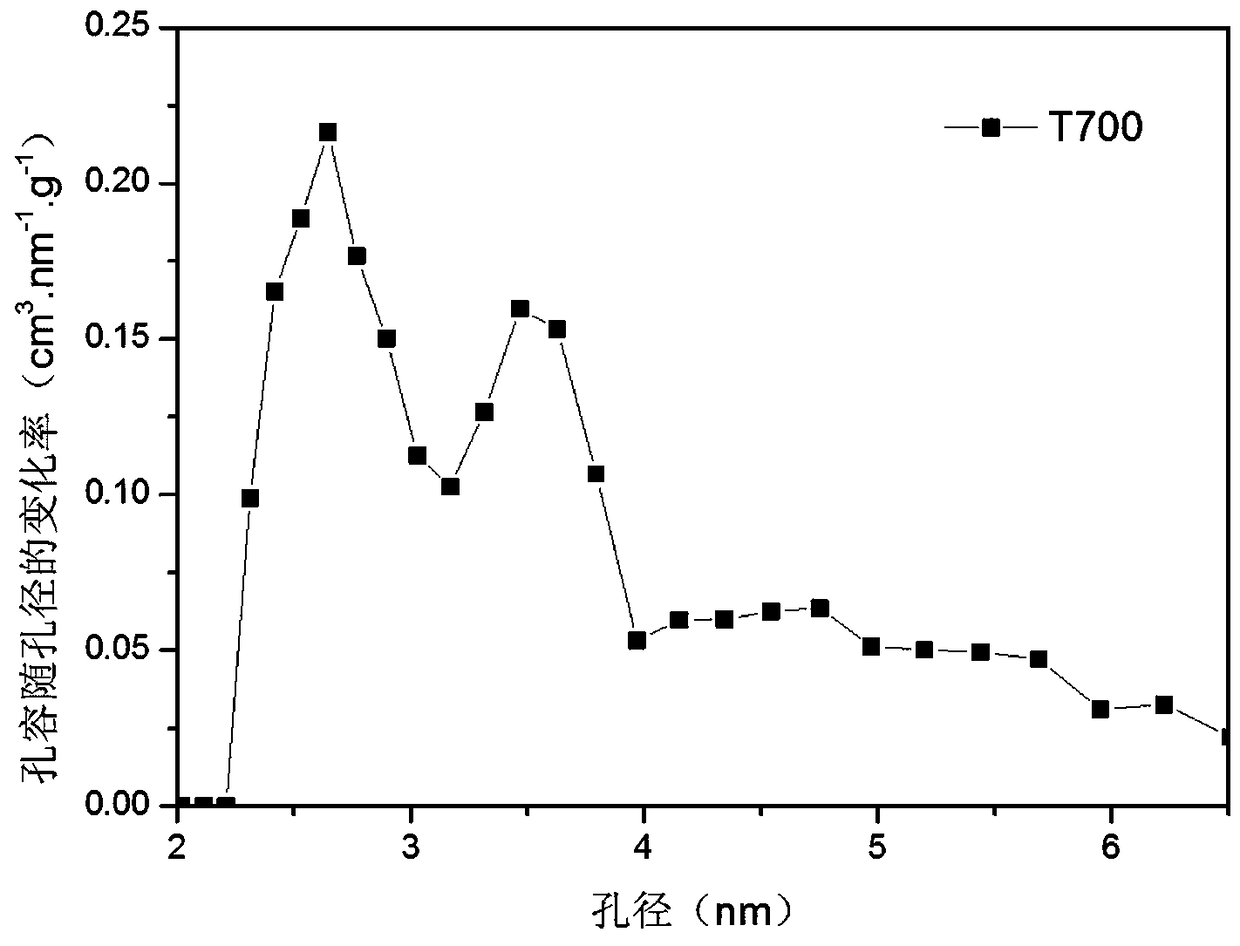Carbon adsorbent for separating of methane and nitrogen and preparation method of carbon adsorbent
A technology of carbon adsorption and nitrogen, which is applied in the preparation of carbon adsorbents and the field of carbon adsorbents for the separation of CH4/N2, to achieve the effects of sufficient raw materials, alleviating environmental protection problems, and good desorption performance
- Summary
- Abstract
- Description
- Claims
- Application Information
AI Technical Summary
Problems solved by technology
Method used
Image
Examples
Embodiment 1
[0034] After removing the sponge floc layer from the corn cob, crush it into a 200-mesh fine powder, mix it with a phosphoric acid solution with a concentration of 7.9% at a mass ratio of 1:6, dry it at 80°C for 40 hours, and crush it through a 60-mesh sieve. Place the pulverized sample in a muffle furnace, under the flow rate of 0.2L / min N 2 In the atmosphere, the temperature was raised to 700°C at a heating rate of 10°C / min, and activated at a constant temperature for 2 hours. The product was taken out, washed with water until neutral, and dried to obtain a carbon adsorbent.
[0035] After vacuuming and degassing the carbon adsorbent prepared above at 300°C for 3 hours, the NOVA1200e adsorption instrument of Quantachrome Company in the United States was used to measure the CH 4 and N 2 Static adsorption capacity of pure components, respectively, 13.1 cm 3 / g and 3.5cm 3 / g,CH 4 / N 2 The equilibrium separation ratio was 3.7.
Embodiment 2
[0037] After removing the sponge floc layer from the corn cob, crush it into a 200-mesh fine powder, mix it with a phosphoric acid solution with a concentration of 17.9% at a mass ratio of 1:6, dry it at 80°C for 40 hours, and crush it through a 60-mesh sieve. Place the pulverized sample in a muffle furnace, under the flow rate of 0.2L / min N 2 In the atmosphere, the temperature was raised to 700°C at a heating rate of 10°C / min, and activated at a constant temperature for 2 hours. The product was taken out, washed with water until neutral, and dried to obtain a carbon adsorbent.
[0038] According to the method of Example 1, measure carbon adsorbent to CH under 298K, 100Kpa 4 and N 2 The static adsorption capacity of the pure components is 13.8 cm 3 / g and 4.0cm 3 / g,CH 4 / N 2 The equilibrium separation ratio is 3.5.
Embodiment 3
[0040] After the sponge floc layer is removed from the corncob, it is crushed into a 200-mesh fine powder, mixed evenly with a phosphoric acid solution with a concentration of 27.9% at a mass ratio of 1:6, dried at 80°C for 40 hours, and crushed through a 60-mesh sieve. Place the pulverized sample in a muffle furnace, under the flow rate of 0.2L / min N 2 In the atmosphere, the temperature was raised to 700°C at a heating rate of 10°C / min, and activated at a constant temperature for 2 hours. The product was taken out, washed with water until neutral, and dried to obtain a carbon adsorbent.
[0041] According to the method of Example 1, measure carbon adsorbent to CH under 298K, 100Kpa 4and N 2 The static adsorption capacity of the pure components is 13.5 cm 3 / g and 4.0cm 3 / g,CH 4 / N 2 The equilibrium separation ratio was 3.4.
[0042] Adopt the NLDFT model to analyze the carbon adsorbent prepared in this embodiment under 273K CO 2 The adsorption isotherm was fitted to ...
PUM
| Property | Measurement | Unit |
|---|---|---|
| adsorption capacity | aaaaa | aaaaa |
| adsorption capacity | aaaaa | aaaaa |
| pore size | aaaaa | aaaaa |
Abstract
Description
Claims
Application Information
 Login to View More
Login to View More - R&D
- Intellectual Property
- Life Sciences
- Materials
- Tech Scout
- Unparalleled Data Quality
- Higher Quality Content
- 60% Fewer Hallucinations
Browse by: Latest US Patents, China's latest patents, Technical Efficacy Thesaurus, Application Domain, Technology Topic, Popular Technical Reports.
© 2025 PatSnap. All rights reserved.Legal|Privacy policy|Modern Slavery Act Transparency Statement|Sitemap|About US| Contact US: help@patsnap.com



